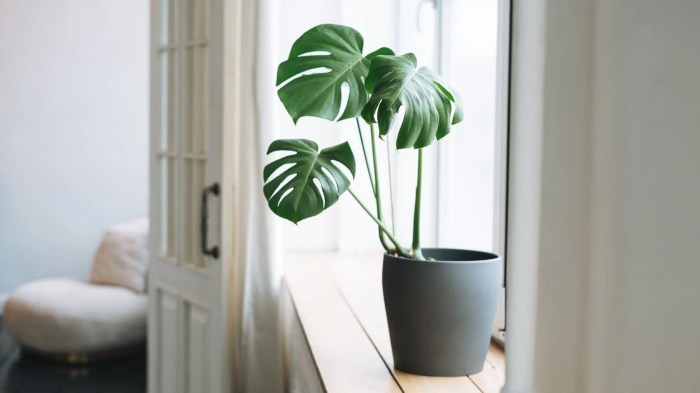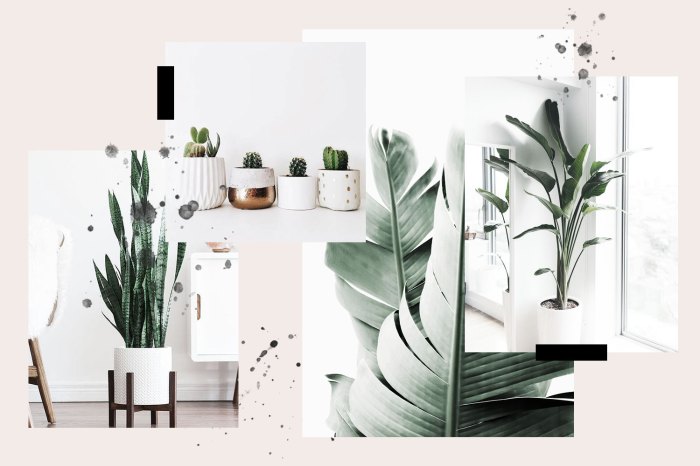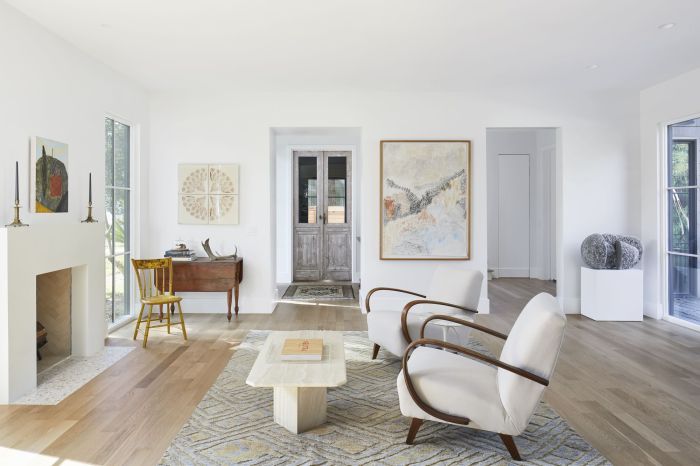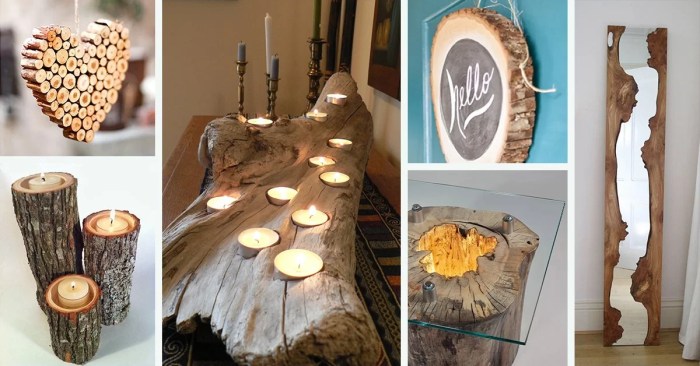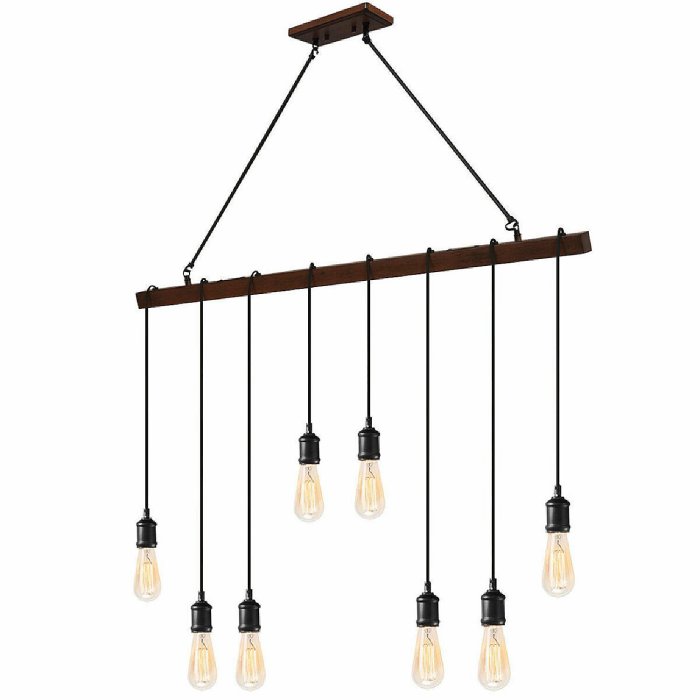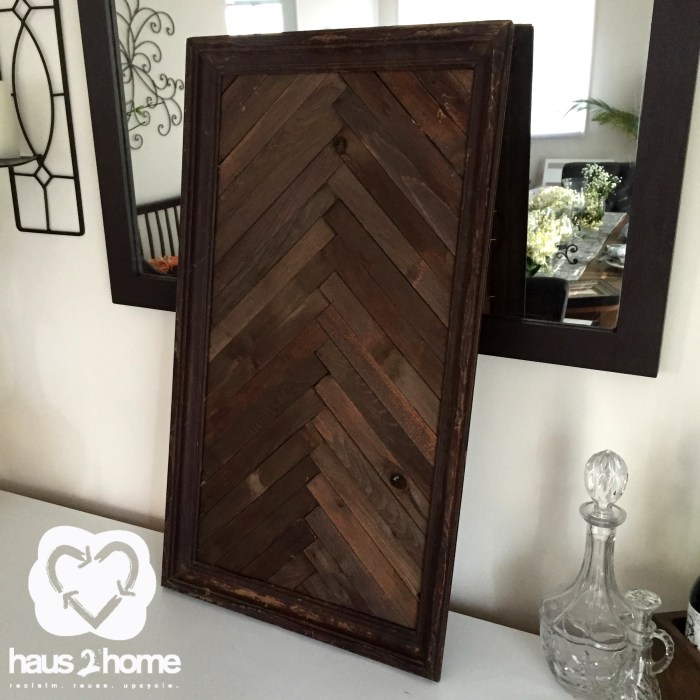Sustainable minimalist home decor transcends mere aesthetics; it’s a conscious lifestyle choice reflecting a harmonious blend of environmental responsibility and streamlined living. This approach prioritizes functionality, durability, and ethical sourcing, minimizing waste and maximizing the positive impact on both our homes and the planet. By carefully selecting materials, embracing mindful consumption, and employing creative DIY techniques, we can cultivate spaces that are both beautiful and sustainable.
This exploration delves into the core principles of sustainable minimalist design, from sourcing eco-friendly materials like reclaimed wood and bamboo to implementing space-saving strategies and upcycling existing items. We’ll examine practical applications across various rooms, offering insights into decluttering, color palette selection, and maximizing natural light. The journey culminates in visualizing the tangible results through detailed examples of sustainable minimalist living rooms and bedrooms, showcasing how these principles translate into calming, functional, and environmentally conscious spaces.
Defining Sustainable Minimalist Home Decor
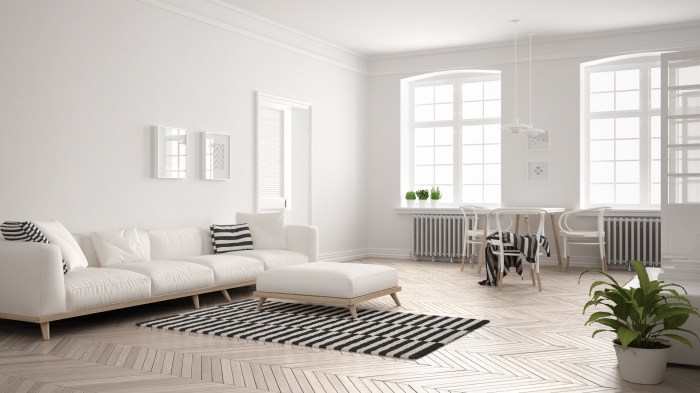
Sustainable minimalist home decor represents a conscious approach to interior design that harmoniously integrates the principles of minimalism and sustainability. It prioritizes functionality, quality over quantity, and the reduction of environmental impact throughout the entire lifecycle of furniture and decor items. This approach goes beyond simply owning less; it advocates for thoughtful consumption and a mindful relationship with the environment and resources.Sustainable minimalist home decor prioritizes the use of eco-friendly materials, durable construction, and ethical sourcing.
The core principles emphasize reducing waste, choosing long-lasting pieces, and repurposing or recycling existing items. This approach aims to create spaces that are both aesthetically pleasing and environmentally responsible, contributing to a healthier planet and a more ethical consumption cycle.
Core Principles of Sustainable Minimalist Home Decor
The core principles guiding sustainable minimalist home decor are interconnected and mutually reinforcing. They represent a holistic approach to designing and inhabiting living spaces. These principles ensure that the pursuit of a minimalist aesthetic does not compromise environmental responsibility. Instead, it enhances it.
- Prioritizing Quality over Quantity: Instead of accumulating numerous inexpensive items that quickly break or become obsolete, sustainable minimalist decor focuses on investing in fewer, high-quality pieces made to last. This reduces the need for frequent replacements and minimizes waste generation.
- Choosing Eco-Friendly Materials: This involves selecting materials with low environmental impact, such as reclaimed wood, bamboo, organic cotton, and recycled metals. The manufacturing processes of these materials should also be considered, prioritizing those with minimal pollution and ethical labor practices.
- Supporting Ethical Sourcing and Production: Sustainable minimalist design emphasizes transparency and accountability in the supply chain. This includes supporting businesses that prioritize fair wages, safe working conditions, and environmentally responsible manufacturing processes for their products.
- Reducing Waste and Embracing Repurposing: Minimizing waste is crucial. This can be achieved by repurposing existing items, repairing damaged furniture instead of replacing it, and choosing products with minimal packaging. Creative reuse of materials is a hallmark of this approach.
- Focusing on Functionality and Versatility: Each item should serve a clear purpose and ideally, multiple functions. Multi-functional furniture or decor pieces optimize space and reduce the need for numerous single-use items.
Environmental and Social Benefits
Adopting sustainable minimalist home decor offers significant environmental and social advantages. By reducing consumption and prioritizing eco-friendly materials, individuals can lessen their carbon footprint and contribute to a healthier planet.
- Reduced Carbon Footprint: The production, transportation, and disposal of furniture and decor items contribute significantly to greenhouse gas emissions. Sustainable minimalist decor minimizes this impact by reducing the overall quantity of goods consumed and selecting products with lower embodied carbon.
- Conservation of Resources: Sustainable materials and reduced consumption directly translate to less strain on natural resources like timber, water, and minerals. The emphasis on durability reduces the need for frequent resource extraction and processing.
- Reduced Waste Generation: By prioritizing quality, durability, and repair, this approach minimizes the amount of waste sent to landfills. This reduces pollution and conserves valuable resources that could be recycled or reused.
- Support for Ethical Labor Practices: Choosing ethically sourced products ensures fair wages and safe working conditions for those involved in the production process. This contributes to social justice and economic empowerment within communities.
Sourcing Sustainable Materials
The foundation of sustainable minimalist home decor lies in the responsible sourcing of materials. Choosing materials with minimal environmental impact requires careful consideration of their lifecycle, from origin to disposal. This involves understanding the manufacturing processes, transportation methods, and the overall carbon footprint associated with each material. Prioritizing materials that are renewable, recyclable, or biodegradable significantly reduces the negative effects on our planet.
Sustainable materials offer a compelling alternative to conventional options, promoting both environmental responsibility and aesthetic appeal. The selection of materials is crucial in determining the longevity and overall sustainability of your home decor.
Sustainable Material Comparison
The following table compares several popular sustainable materials commonly used in home decor, highlighting their advantages and disadvantages, along with typical sourcing options.
| Material | Pros | Cons | Sourcing Options |
|---|---|---|---|
| Reclaimed Wood | Unique character, durable, reduces deforestation | Can be expensive, may require significant restoration, availability varies | Salvage yards, demolition sites, specialized lumber suppliers |
| Bamboo | Rapidly renewable, strong, aesthetically pleasing | Susceptible to moisture damage if not properly treated, can be less durable than hardwood in some applications | Online retailers specializing in sustainable materials, home improvement stores |
| Organic Cotton | Soft, breathable, biodegradable, reduced pesticide use | Can be more expensive than conventionally grown cotton, may require more careful washing and care | Online retailers focusing on organic textiles, local craft stores, farmers’ markets |
| Recycled Glass | Durable, aesthetically versatile, reduces landfill waste | Can be more brittle than new glass, sourcing specific colors may be challenging | Glass recycling centers, artisan glassblowers, online retailers specializing in recycled glass |
Ethically Sourced Furniture and Decor Examples
Several companies prioritize ethical sourcing and sustainable manufacturing practices. These companies often provide transparency regarding their supply chains and production methods, allowing consumers to make informed choices.
For example, a company might utilize reclaimed wood from deconstructed barns to create unique coffee tables, showcasing the material’s history and reducing waste. Another company could focus on producing organic cotton rugs, emphasizing fair labor practices and environmentally friendly dyes. Similarly, a furniture maker might source bamboo from sustainably managed forests, ensuring responsible harvesting and minimal environmental impact.
These examples demonstrate a commitment to sustainability throughout the entire production process.
Resources for Finding Sustainable Materials
Finding sustainable materials for home decor projects is becoming increasingly accessible. A variety of resources are available to assist in sourcing ethically produced items and materials.
Online retailers specializing in sustainable home goods offer a wide selection of products with transparent sourcing information. Local craft fairs and farmers’ markets can provide opportunities to connect directly with artisans and producers, ensuring ethical sourcing and supporting local economies. Furthermore, salvage yards and demolition sites can be excellent sources for reclaimed materials, offering unique and sustainable options for home decor projects.
Finally, specialized lumber yards often carry sustainably harvested wood, providing a responsible alternative to conventionally sourced lumber.
Minimalist Design Principles in Practice

Applying minimalist principles to home decor isn’t about deprivation; it’s about intentionality. It’s about curating a space that fosters calm, functionality, and a connection to the essentials, thereby reducing stress and environmental impact. This involves thoughtful selection of furniture, accessories, and color palettes, leading to a space that is both aesthetically pleasing and environmentally conscious.
Living Room Minimalism
The living room, often the heart of the home, benefits significantly from a minimalist approach. Overcrowding this space with unnecessary furniture creates visual clutter and restricts movement. Instead, consider a modular sofa system that can adapt to various needs, paired with a single statement piece like a carefully chosen rug made from sustainable materials, such as recycled cotton or wool.
A few strategically placed plants, chosen for their air-purifying qualities (like snake plants or spider plants), can add life and texture without overwhelming the space. Avoid excessive throw pillows and blankets; instead, opt for high-quality, versatile pieces. Open shelving, if used, should display only a few carefully curated items, possibly books or a small collection of decorative objects with personal significance.
This curated selection prevents the shelves from becoming visually chaotic.
Bedroom Minimalism
The bedroom should be a sanctuary of rest and relaxation. Minimalism in this space prioritizes comfort and functionality. Choose a bed frame and mattress that prioritize quality and longevity over fleeting trends. A simple nightstand with a lamp and a few essential items suffices. Declutter the space by storing away non-essential clothing and accessories in carefully chosen storage solutions.
Opt for a calming color palette—think muted greens, blues, or grays—to promote relaxation. Natural materials like linen or organic cotton for bedding contribute to both comfort and sustainability. Avoid overly decorative bedspreads or excessive textiles; simplicity is key. Good quality, natural light is also crucial for promoting healthy sleep cycles.
Kitchen Minimalism
The kitchen, a hub of activity, can benefit from strategic minimalism. Invest in high-quality, durable appliances and cookware that are designed to last. Avoid accumulating duplicate items or gadgets you rarely use. Open shelving can be utilized, but only for frequently used items, organized neatly. Choose a limited color palette for your cabinets and countertops, emphasizing functionality over decorative elements.
This approach creates a clean and efficient workspace. Employ vertical storage solutions to maximize space and minimize clutter. Remember, a clutter-free kitchen facilitates a smoother and more enjoyable cooking experience.
Bathroom Minimalism
The bathroom is another area where minimalist principles significantly improve functionality. Keep only essential toiletries and cleaning supplies, opting for refillable containers to reduce waste. A simple vanity with sufficient storage will minimize clutter. Choose towels and bath mats made from sustainable materials like organic cotton or bamboo. A minimalist approach helps to maintain a clean and hygienic space, which is crucial in a bathroom.
Avoid excessive decorative items; a few carefully selected plants or a simple piece of art can add visual interest without overwhelming the space.
Decluttering and Organizing with Minimalist Techniques
Effective decluttering involves a systematic approach. Begin by removing all items from a space, then evaluate each item individually. Ask yourself: Is this item functional? Do I truly love this item? Does it serve a purpose?
If the answer to all three questions is no, the item should be donated, recycled, or discarded responsibly. Once decluttered, organize the remaining items using storage solutions that maximize space and minimize visual clutter. Vertical storage, clear containers, and labeled shelves are all effective tools. This process, when applied consistently, leads to a significantly more organized and functional living space.
Color Palette and Natural Light
A limited color palette, incorporating neutral tones and accent colors, creates a calming and unified atmosphere. Neutral colors like whites, grays, and beiges provide a clean backdrop that makes other elements stand out. Accent colors, used sparingly, add personality and visual interest without overwhelming the space. Natural light is crucial; maximizing natural light sources through window placement and the use of light-colored walls and furnishings brightens the space and reduces the need for artificial lighting, saving energy and promoting a healthier living environment.
This combination of thoughtful color choices and natural light creates a space that is both visually appealing and conducive to well-being.
DIY and Upcycling Techniques
Embracing DIY and upcycling is fundamental to sustainable minimalist home decor. These practices not only reduce waste by repurposing existing materials but also allow for the creation of unique, personalized pieces that reflect individual style while minimizing environmental impact. The process often involves a blend of creativity, resourcefulness, and a respect for the materials at hand. By learning basic techniques and understanding the properties of various materials, anyone can contribute to a more sustainable lifestyle through home decor.
Macrame Wall Hanging from Recycled Rope
Creating a macrame wall hanging from recycled rope offers a tangible example of sustainable DIY. This project transforms discarded rope into a visually appealing and functional piece of home decor. The process is surprisingly straightforward, requiring minimal tools and readily available materials.
- Gather Materials: Source recycled rope (from old sails, packaging, or even discarded clothing). Choose a rope with a suitable thickness and texture for your desired aesthetic. You will also need scissors, a measuring tape, and potentially a wooden dowel or branch for the hanging piece. Depending on the complexity of your design, you may wish to include beads or other small, sustainable embellishments.
- Prepare the Rope: Measure and cut the necessary lengths of rope. The amount will depend on the size and complexity of your design. A simple wall hanging might require four to six strands of varying lengths, while a more elaborate piece could require many more.
- Create the Foundation: Gather the cut rope strands and tie them securely around the wooden dowel or branch. Ensure the knot is tight and well-secured to prevent unraveling.
- Basic Macrame Knots: Familiarize yourself with fundamental macrame knots, such as square knots and half-hitches. These knots form the basis of most macrame patterns. Numerous online tutorials and books detail the precise techniques for tying these knots.
- Pattern Creation: Following a chosen pattern (or creating your own), begin tying the knots systematically along the rope strands. This step requires patience and attention to detail. The pattern determines the final look of the wall hanging.
- Finishing Touches: Once the desired pattern is complete, trim any loose ends neatly. You can also add beads or other embellishments at this stage, further personalizing the piece.
Upcycling Furniture and Decor Items
Upcycling transforms discarded or unwanted furniture and decor into something new and valuable. This process involves adding creativity and skill to existing items, extending their lifespan and reducing the demand for new, resource-intensive products.
- Repurposing Old Chairs: An old wooden chair can be revitalized with a fresh coat of paint, new upholstery made from recycled fabric, or by incorporating it into a unique garden feature.
- Transforming Glass Jars: Empty glass jars can become stylish storage containers, vases, or even candle holders with minimal effort. A simple wash and a decorative ribbon or paint can drastically change their appearance.
- Revitalizing Wooden Pallets: Discarded wooden pallets can be disassembled and repurposed into shelves, headboards, or even small tables. Sanding, cleaning, and applying a protective finish are crucial steps.
Tools and Materials for DIY and Upcycling
The tools and materials required for DIY and upcycling projects vary greatly depending on the specific project. However, a basic toolkit is useful for many common tasks.
Common tools include: scissors, measuring tape, screwdrivers (Phillips and flathead), pliers, sandpaper, paintbrushes, and a drill (optional). Materials will depend on the project but often include paint, recycled fabrics, rope, wood, and glue.
Reducing Environmental Impact
Sustainable minimalist home decor is not merely an aesthetic choice; it’s a powerful tool for mitigating our environmental footprint. By consciously selecting materials, minimizing waste, and optimizing energy use, we can significantly reduce the negative impact of our living spaces on the planet. This involves a holistic approach, encompassing everything from the sourcing of materials to the disposal of items at the end of their life cycle.The environmental impact of home decor is substantial, contributing to deforestation, pollution, and greenhouse gas emissions.
Conventional manufacturing processes often involve energy-intensive methods, the use of toxic chemicals, and the generation of significant waste. However, by adopting sustainable practices, we can drastically reduce this impact, creating homes that are both aesthetically pleasing and environmentally responsible. For example, choosing locally sourced, reclaimed wood for furniture instead of mass-produced options from distant factories reduces transportation emissions and supports local economies.
The lifecycle assessment of a product, considering its entire journey from raw material to disposal, becomes crucial in making informed, eco-conscious choices.
Waste Minimization Strategies
Effective waste minimization requires a multi-pronged approach. It begins with careful consideration of purchases, favoring durable, high-quality items over cheap, disposable ones. Repairing and repurposing existing furniture and decor items, rather than immediately discarding them, extends their lifespan and reduces the demand for new products. Prioritizing reusable and recyclable materials, and properly disposing of non-recyclable items, further minimizes waste generation.
For instance, instead of buying new throw pillows, consider upcycling old clothes or fabrics. The simple act of choosing a durable, repairable piece of furniture over a cheaper, easily damaged one can significantly reduce long-term waste. The average lifespan of a piece of furniture is often much longer when repair is prioritized over replacement.
Reducing the Carbon Footprint of Home Decor
Reducing the carbon footprint of home decor necessitates conscious purchasing decisions and sustainable practices. Opting for locally sourced materials minimizes transportation emissions associated with shipping goods across long distances. Choosing materials with low embodied energy – the total energy consumed throughout a product’s life cycle – further reduces the environmental impact. Bamboo, for example, is a rapidly renewable resource requiring minimal processing and possessing a lower carbon footprint compared to many hardwoods.
Similarly, using recycled materials in decor items significantly reduces the demand for virgin resources and lowers associated emissions. Consider supporting businesses committed to sustainable manufacturing practices and transparent supply chains, ensuring that the environmental impact of the products is minimized throughout their entire life cycle. A study by the Ellen MacArthur Foundation estimates that the fashion industry alone is responsible for about 10% of global carbon emissions, highlighting the significant environmental impact of even seemingly small consumer choices.
Checklist for Environmentally Friendly Home Decor
Prioritizing environmentally friendly home decor involves a series of conscious actions. The following checklist provides actionable steps homeowners can take to minimize their environmental impact:
- Source materials responsibly: Prioritize locally sourced, recycled, or sustainably harvested materials.
- Choose durable, repairable items: Invest in high-quality items designed to last, reducing the need for frequent replacements.
- Repair and repurpose existing items: Extend the lifespan of furniture and decor by repairing damage and finding creative ways to repurpose them.
- Minimize waste: Opt for reusable and recyclable materials and dispose of non-recyclable items responsibly.
- Reduce energy consumption: Choose energy-efficient lighting and appliances.
- Support sustainable businesses: Patronize companies committed to ethical and environmentally responsible practices.
- Consider the lifecycle of products: Evaluate the entire journey of a product, from sourcing to disposal, before purchasing.
Visual Representation
Visualizing sustainable minimalist home decor translates abstract principles into tangible spaces. The following examples illustrate how mindful material choices, pared-down aesthetics, and considered design can create calming, functional, and environmentally responsible living and sleeping areas. The emphasis is on natural light, breathable fabrics, and a sense of spaciousness, all contributing to a healthier and more sustainable lifestyle.
Living Room Designs Exemplifying Sustainable Minimalist Home Decor
Three distinct living room designs showcase the versatility of sustainable minimalist principles. Each design prioritizes natural materials, neutral color palettes, and a focus on functionality over superfluous ornamentation. The resulting spaces are both aesthetically pleasing and environmentally conscious.
- Design 1: The Scandinavian Sanctuary. This design features light-colored, sustainably harvested wood flooring (such as reclaimed oak or FSC-certified pine), complemented by a light grey, organic cotton sofa. A single, statement piece of furniture, perhaps a vintage mid-century modern chair reupholstered in linen, adds visual interest. Walls are painted in a soft, warm white, maximizing natural light. Textural elements include a hand-woven wool rug and a few carefully chosen plants in ceramic pots.
The overall mood is calm, airy, and inviting, evoking feelings of serenity and tranquility. The use of light colors and natural materials reflects the principles of Scandinavian design, known for its functionality and connection to nature.
- Design 2: The Industrial Chic Haven. This design utilizes reclaimed wood for shelving and coffee tables, showcasing the beauty of naturally aged materials. Metal accents, possibly from recycled steel or aluminum, add a touch of industrial flair. A dark grey, durable sofa made from recycled cotton or organic linen provides a grounding element. The color palette is muted, featuring greys, blacks, and natural wood tones.
Textural contrast is achieved through the use of exposed brick walls (where appropriate) and a jute rug. The overall mood is sophisticated, slightly edgy, and functional, conveying a sense of modern simplicity and environmental responsibility. The repurposed materials tell a story of sustainability and resourcefulness.
- Design 3: The Earthy Retreat. This design embraces natural textures and earthy tones. Furniture is crafted from bamboo or sustainably harvested rattan. Walls are painted in warm, neutral tones like terracotta or sage green. A large jute rug anchors the space, adding warmth and texture. Accessories include woven baskets for storage and plants in terracotta pots.
The overall mood is warm, inviting, and grounding, promoting feelings of comfort and connection to nature. The use of bamboo and rattan highlights the strength and beauty of rapidly renewable resources.
Bedroom Designs Exemplifying Sustainable Minimalist Home Decor
Creating a restful and sustainable bedroom involves careful consideration of materials and design. These examples highlight the importance of breathable fabrics, natural light, and a clutter-free environment conducive to sleep.
- Design 1: The Tranquil Oasis. This design prioritizes natural light and calming colors. Walls are painted in a soft, pale blue or green, creating a serene atmosphere. The bed features a simple frame made from sustainably sourced wood, dressed with organic cotton sheets and a linen duvet. A small, simple bedside table made from reclaimed wood holds a lamp and a few books.
A natural fiber rug adds warmth underfoot. The overall mood is peaceful and restorative, promoting relaxation and restful sleep. The minimalist approach maximizes space and minimizes visual clutter, contributing to a sense of calm.
- Design 2: The Modern Minimalist Sanctuary. This design incorporates sleek lines and neutral colors. The bed frame is made from sustainably sourced wood with a simple, unadorned design. The color palette is predominantly white or light grey, with accents of natural wood. Bedding is made from organic cotton or linen. A small, minimalist dresser provides storage.
The overall mood is clean, modern, and calming, fostering a sense of order and tranquility. The focus on functionality and clean lines emphasizes efficiency and reduces environmental impact through reduced material consumption.
- Design 3: The Rustic Retreat. This design utilizes natural materials and rustic textures. The bed frame is made from reclaimed wood, showcasing its unique character. Walls are painted in a warm, earthy tone. Bedding is made from organic cotton or wool. Storage is provided by woven baskets and a simple wooden chest.
The overall mood is cozy, rustic, and inviting, creating a feeling of warmth and comfort. The use of reclaimed wood adds character and reduces waste.
Ultimately, sustainable minimalist home decor offers a pathway towards a more mindful and eco-conscious lifestyle. By embracing the principles of simplicity, durability, and ethical sourcing, we can create homes that are not only aesthetically pleasing but also contribute to a healthier planet. The journey involves conscious choices – from selecting sustainable materials and employing DIY techniques to minimizing waste and energy consumption.
The result? A space that reflects our values, promotes well-being, and leaves a lighter footprint on the Earth. This is more than just interior design; it’s a testament to our commitment to a sustainable future.
Popular Questions
What is the difference between minimalist and sustainable decor?
Minimalist decor focuses on simplicity and functionality, removing clutter. Sustainable decor prioritizes environmentally friendly materials and practices. Sustainable minimalist decor combines both, emphasizing simplicity with eco-conscious choices.
How can I find truly sustainable materials?
Look for certifications like Forest Stewardship Council (FSC) for wood, Global Organic Textile Standard (GOTS) for textiles, and research companies with transparent supply chains and ethical labor practices. Local artisans and reclaimed materials are also excellent options.
Is sustainable decor more expensive?
Initially, some sustainable materials may be pricier. However, the durability and longevity of these materials often offset the higher upfront cost. DIY and upcycling further reduce expenses while minimizing environmental impact.
How can I declutter effectively in a minimalist style?
Start by identifying items you truly need and use regularly. Donate, sell, or recycle unwanted items. Organize remaining possessions efficiently, maximizing storage space and minimizing visual clutter.
What are some low-impact cleaning products for a sustainable home?
Opt for plant-based, biodegradable cleaning products. Vinegar, baking soda, and lemon juice are effective and environmentally friendly alternatives to harsh chemical cleaners.
